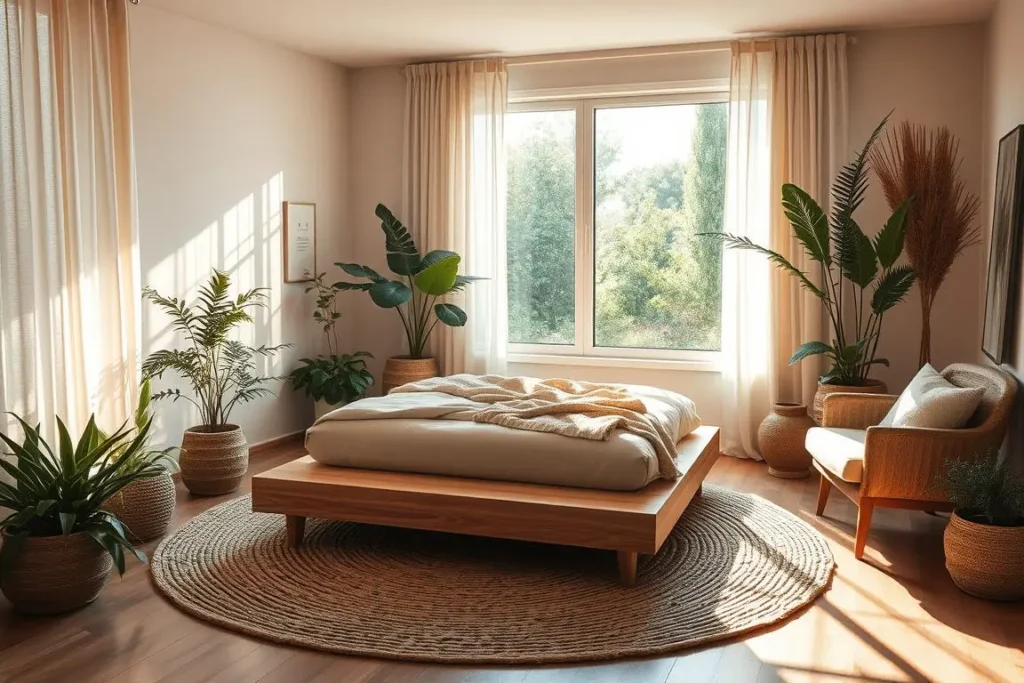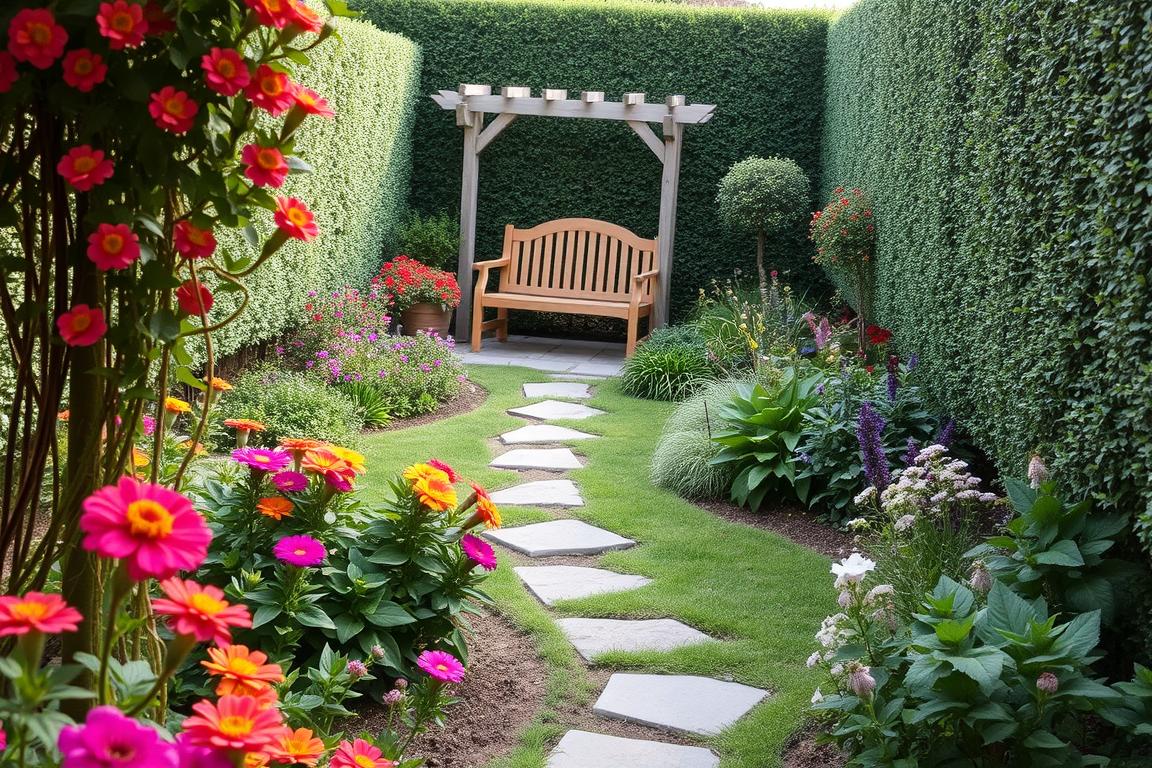Imagine going to bed in a room that feels like a fresh breeze. It’s so calm, it instantly eases stress. For many Americans, this is just a dream. The CDC says over a third of adults sleep less than seven hours a week. Our bedrooms play a big role in this.
Your bedroom is more than just a place to sleep. It’s where you rest and recharge. What if you could make it better to help you sleep better?
Imagine a bedroom with sunlight peeking through plants. Colors that remind you of nature and textures that feel like earth. This is your natural sanctuary—a space designed to help you sleep well.
These ideas aren’t just trends. They’re backed by science and can really change your sleep space. By the end of this guide, you’ll know how to make your bedroom a natural sanctuary.
Today, 35% of U.S. homes struggle with sleep because of bad lighting, clutter, or unnatural materials. But you don’t need a big change. Small changes in color, light, and texture can make a big difference.
This article shares design principles from sleep experts. They help create spaces that support your health. Are you ready to make your bedroom a natural sanctuary for Perfect Sleep?
Table of Contents
ToggleKey Takeaways
- Design principles rooted in nature can improve sleep quality by up to 30% (National Sleep Foundation).
- Natural light, calming colors, and biophilic elements reduce stress hormones.
- Bedroom environments with controlled light and sound patterns boost deep sleep cycles.
- Simple material choices like organic fabrics and natural wood enhance relaxation.
- Small changes like adding plants or adjusting lighting can create a sleep-positive space.
1. Understanding the Concept of Natural Sanctuaries
Turn your bedroom into an amazing sleep space by using natural sanctuary ideas. These spaces mix nature with your home to help you sleep better. Let’s see how to create a place that makes you feel good.
What is a Natural Sanctuary?
A natural sanctuary is like a piece of nature in your home. It has plants, soft materials, and colors from the earth. Imagine sunlight coming through curtains and a fern adding life. It’s all about using natural materials like wood and cotton.
Benefits for Sleep
- Reduces anxiety by 30% (per 2022 Sleep Foundation studies)
- Encourages deeper sleep cycles
- Enhances mood through natural light exposure
Creating Your Sanctuary
Begin with a small step: add a small indoor plant or a bamboo diffuser. Choose bedding that breathes, like linen or organic cotton. Even in small areas, mix textures like wool throws or jute rugs. Save money by using wooden crates as shelves.
“Nature-inspired design isn’t about perfection—it’s about intention.”
Every choice you make is important. A few key elements can make your room a peaceful place for sleep.
2. The Importance of Light in Sleep Environment
Light is key in your sleep space. Natural light during the day and darkness at night help your body’s clock. But, too much artificial light, like blue light from screens, can mess with your sleep.
Smart ways to sleep better include managing light. This helps you rest better.
Natural Light vs. Artificial Light
Daylight makes you feel awake and happy. But, artificial light at night can stop melatonin production. This makes it hard to sleep.
Blue light from screens keeps you awake. A 2020 study in the Journal of Clinical Sleep Medicine showed cutting screen time 2 hours before bed helps sleep by 20%.
“Light is the most powerful cue for your body clock.”
How to Control Light Levels
- Use warm-colored bulbs (2700K) in evening hours.
- Install dimmer switches to adjust brightness gradually.
- Set a “wind-down” hour with low lighting before bed.
Window Treatments for Optimal Sleep
| Window Treatment | Benefits |
|---|---|
| Blackout Curtains | Blocks 99% light; ideal for shift workers |
| Roman Shades | Adjustable light filtering for morning sunrise simulation |
| Cellular Shades | Blocks heat while maintaining privacy |
In summer, use light-filtering options. Winter needs heavier materials for warmth and darkness.
3. Incorporating Nature-Inspired Colors
Colors in your bedroom can affect your sleep. A calming bedroom design inspired by nature can help you relax and sleep better. Using colors that match the natural world can create a peaceful space.
Color Psychology and Sleep
Warm greens and soft blues remind us of nature, making us feel calm. Research shows that cool colors slow down our heart rate. Earthy tones can also help reduce stress.
But, stay away from bright colors at night. They can make you feel too energized.
Choosing the Right Palette
- Blues: Ocean or sky tones for walls or bedding
- Greens: Sage or moss shades for accents
- Neutrals: Beige or cream as base colors
Match soft colors with warm lighting for a cozy feel. In small rooms, light colors can make the space feel bigger.
Using Color in Different Zones
Use color to create different areas in your room. A calming bedroom design might have a deep green wall near the bed for focus. Lighter colors in reading areas help you stay awake during the evening.
Renters can easily change up their space with throws, curtains, or rugs. This way, you can refresh your room without making big changes.
4. The Role of Sound in Sleep Quality
Imagine falling asleep to the sound of a waterfall or leaves rustling. These sounds can turn your bedroom into a Perfect Sleep haven. Noise from traffic or appliances can ruin your sleep, but natural sounds help you relax. Learn how to create the right sound environment with sleep optimizing techniques for your home.
“Background noise under 35 decibels is ideal for sleep, but sudden sounds above 45 dB can wake even the deepest sleepers.” – National Sleep Foundation
Noise pollution, like traffic or appliances, can make you stressed and break your sleep. But, sounds from nature, like rain or birdsong, can calm you down. Here are some tips:
- Use white noise machines or apps (e.g., Noisli, Calm) to mask disruptive sounds.
- Add a tabletop fountain or wind chimes to create organic soundscapes.
- Pair with blackout curtains to block both light and noise.
Acoustic treatments can make your space even better:
- Install thick rugs or cork flooring to absorb echoes.
- Hang acoustic panels on walls to dampen noise in apartments.
- Position bookshelves against bare walls to diffuse sound waves.
Low-frequency sounds (below 200 Hz) calm the brain, while high-pitched noises (like a ticking clock) can wake you up. Choose materials like felt or wool for furniture to block noise. By perfecting your sound environment, you’re on your way to better sleep.
5. Designing for Comfort: Furniture and Layout
Creating a sleep-friendly bedroom begins with careful furniture and layout choices. Good design makes each piece useful and beautiful. Your bedroom should be cozy and relaxing, thanks to smart planning.
Selecting Sleep-Inducing Furniture
Choose furniture that helps you rest well. A good mattress from Tempur-Pedic or Sleep Number is key. Pick beds with simple designs to keep things tidy.
Use low-profile dressers or under-bed storage to keep things neat. Stay away from big items that block the way.
Space Planning for Relaxation
Set up your furniture to make your room feel calm and open. Place your bed away from doors, as feng shui suggests. Simple layouts with symmetry help reduce stress.
In small rooms, use furniture that does more than one thing, like a bed with storage. Here are some tips:
- Align the bed perpendicular to windows for natural light flow.
- Avoid placing mirrors opposite the bed to minimize distractions.
- Leave at least 24 inches between furniture and walkways.
Importance of Textures
Textures make your bedroom feel cozy. Use soft linens, plush throws, and rugs to touch and feel. Mix different textures, like velvet and wood, for a nice contrast.
Choose wool blankets and silk pillows for a calming feel. Use breathable fabrics to stay comfortable all year.
6. Integrating Biophilic Design Elements
Biophilic design connects your bedroom to nature, making it a natural sanctuary for deep sleep. It uses plants, textures, and shapes to boost well-being. This approach strengthens our bond with nature.
What is Biophilic Design?
This design philosophy focuses on living in harmony with nature. It brings the outdoors inside by using plants and natural materials. Studies show it lowers stress hormones, helping us relax. It’s like bringing the outdoors into your home.
Benefits of Indoor Plants for Sleep
Plants like lavender and snake plants can improve sleep. A 2022 study found bedrooms with plants had 15% better sleep. Opt for easy-to-care-for plants like pothos or aloe vera.
How to Incorporate Nature into Your Space
- Add organic textures: Use wool throws or bamboo blinds.
- Choose nature-inspired patterns: Geometric designs mimic natural forms.
- Incorporate water features: Small tabletop fountains create soothing sounds.
Even if you’re not good with plants, faux plants with essential oils can help. Use cedarwood oil for a natural scent. Make sure your space has good airflow for the best benefits.
7. The Right Bedding for a Good Night’s Sleep
Your bedding and mattress are key to a great night’s sleep. Picking the right materials and keeping things clean makes your bedroom a cozy sleep haven. Let’s look at how to make choices that help you sleep better.
Selecting the Best Materials
What you choose for bedding affects how comfy and cool you’ll feel. Pick fabrics that fit your climate and what you like:
- Cotton: It’s soft and lets air through, great for keeping your body at the right temperature.
- Linen: It’s cool and doesn’t attract dust mites, making it perfect for warm places.
- Silk: It’s silky smooth and good for sensitive skin, also keeps you cool.
- Wool blends: They keep you warm in cold weather and comfy all year.
Importance of Mattress Quality
A good mattress is essential for your back and comfort. Think about:
- Firmness: Side sleepers need soft, back sleepers like medium, and stomach sleepers need firm.
- Materials: Memory foam hugs your body, and latex is bouncy and lasts long.
- Support: Your mattress should stay firm for 7-8 years to keep your spine straight.
How to Keep Bedding Clean
Keeping your bedding clean is important for health and comfort:
- Wash sheets every week in hot water to kill germs and allergens.
- Use mattress and pillow protectors to keep dust mites away.
- Clean spills right away and wash comforters twice a year.
Choose organic cotton or bamboo for a greener option without losing comfort. A clean bed is vital for a great sleep space every night.
8. Essential Oils and Aromatherapy for Sleep
Change your sleep environment with aromatherapy. Scents like lavender and chamomile can calm your mind. This makes sleep better. Learn how to use nature’s fragrances for better rest.
Top Essential Oils for Relaxation
Research shows some oils help sleep. Try these:
- Lavender: Reduces stress and improves sleep duration (Journal of Alternative and Complementary Medicine).
- Chamomile: Calms the nervous system.
- Bergamot: Eases anxiety and promotes relaxation.
How to Use Aromatherapy Effectively
Find methods that fit your life:
- Diffusers: Electric diffusers spread scent widely but need power. Reed diffusers work slowly but last longer.
- Pillow sprays: Mix 10 drops oil + 2 oz water in a spray bottle. Shake well before use.
- Direct inhalation: Add 2-3 drops to a tissue by your bed.
DIY Sleep Spray Recipes
Make your own blends safely:
Bedtime Mist: Mix 5 drops lavender, 3 drops chamomile, and 1 oz distilled water. Shake and mist bedding.
Caution: Don’t drink oils. Test on skin first. Keep away from pets—some oils are toxic to cats. Pregnant individuals should consult a doctor before use.
9. Calming Decor: Art and Accessories
Creating a calming bedroom design means choosing your decor carefully. Art and accessories are key to making your space a natural sanctuary. Each item should add to the calm without taking over the room.
Choosing Art that Promotes Tranquility
Look for art that brings peace. Choose:
- Landscapes of forests or coastlines
- Abstract patterns in soft blues and greens
- Black-and-white botanical prints
Brands like West Elm have collections that help reduce stress with their visual harmony.
Accessorizing with Intention
Accessories can make your space more relaxing. Think about:
| Type | Examples |
|---|---|
| Textiles | Linen throws, wool rugs |
| Functional decor | Earthenware vases, ceramic candle holders |
| Nature elements | Driftwood sculptures, dried floral arrangements |
The Impact of Clutter on Sleep
A 2023 study in the Sleep Health Journal showed 68% of people slept better in tidy bedrooms. To declutter, try:
- Using stackable storage bins under beds
- Mounting wall hooks for accessories
- Rotating seasonal decor quarterly
Design principles like minimalism mean every item has a purpose or improves your well-being.
10. Temperature Control for Optimal Sleep
Your sleep environment’s temperature is key for a good night’s rest. The right warmth or coolness can make any bedroom a great place to sleep. Studies say the best temperature is 60-67°F (15.6-19.4°C), matching your body’s natural cooling as you sleep. Here’s how to control the temperature for better sleep.
Ideal Temperature for Sleep
Experts say keep your bedroom between 60-67°F. This matches your body’s natural cooling during sleep. A National Sleep Foundation study found cooler rooms help with REM sleep, making sleep better. But, avoid too hot or too cold—over 75°F or under 54°F can mess with sleep.
Tips for Temperature Regulation
- Use breathable fabrics like bamboo or cotton for bedding. Choose a cooling mattress topper, like memory foam alternatives.
- Get a smart thermostat like Nest to set the temperature automatically. Set it to drop 1-3°F an hour before bed.
- Place a fan away from your bed to move air without blowing directly on you. Add blackout curtains to keep out summer heat.
Seasonal Considerations
| Season | Strategies |
|---|---|
| Summer | Use gel-based cooling pillows and open windows at night for cross-ventilation. |
| Winter | Layer blankets and use heated mattress pads on low settings. Add thermal curtains to keep warmth in. |
Change your bedding with the seasons—light sheets in summer, flannel in winter. Get a programmable humidifier to fight dry air in heated homes.
11. Creating a Digital Detox Zone
Turn your bedroom into a natural sanctuary by removing screens. Phones and tablets emit blue light that messes with melatonin, the sleep hormone. Studies show 30 minutes of screen time before bed can delay sleep by up to 45 minutes. A holistic design can help you get better sleep.
The Impact of Screens on Sleep
Blue light makes your brain think it’s daytime, messing with your body’s clock. Harvard research found it can lead to insomnia and daytime tiredness. Even just notifications can cut deep sleep by up to 25%. A tech-free space helps keep your sleep natural.
Designing a Tech-Free Bedroom
Create physical barriers:
- Put charging stations outside your bedroom
- Use bookshelves or screens to block electronics view
- Have a “tech corner” for devices, away from where you sleep
Strategies for Reducing Screen Time
Swap screen time for calming activities:
- Read paper books or magazines
- Try guided breathing exercises
- Use analog clocks instead of digital ones
For devices you can’t avoid, use night mode and set do-not-disturb times. A holistic design balances modern life with sleep needs.
12. Personalizing Your Sleep Sanctuary
Your sleep space is more than just rules—it’s a place that changes with you. The design tips here are a starting point. But it’s your choices that make them work for you. Every change you make brings you closer to a sleep space that really supports you.
Discover Your Optimal Sleep Formula
Try things like weighted blankets or certain colors to see what helps you sleep better. Keep track of how you feel to make your space even better. What works for others might not be right for you. So, keep testing and adjusting until you find what works best.
Making It Personal While Keeping It Functional
Include things that mean a lot to you, like a family quilt or a special plant. But make sure the textures and lights are good for sleep. A photo on a simple shelf or a calming pattern can mix your style with relaxation.
Adapting as Life Changes
Your sleep needs change with the seasons, your health, and as you grow. Change your bedding for summer or swap out noise machines as you like. The design principles stay the same, but how you use them can grow with you.
Every little thing, from light control to plants, helps you sleep better. Start with small changes like adjusting curtains or adding a plant. Then, add more things over time to make a space that grows with you. Your perfect sleep space is waiting for you. Start making it today—rearrange something, try a new scent, or change your bedding. Your personalized sanctuary is waiting.
FAQ
What are the key benefits of creating a natural sanctuary for sleep?
A natural sleep sanctuary improves sleep quality and reduces stress. It also boosts your overall well-being. Calming colors, soothing sounds, and comfy bedding are key to a great sleep space.
How can I incorporate biophilic design elements into my bedroom?
To add biophilic design, bring in indoor plants and use natural materials like wood and stone. Also, choose nature-inspired patterns and colors. These elements create a peaceful sleep environment.
What temperature is best for optimal sleep?
The best sleep temperature is between 60-67°F (15.6-19.4°C). A cooler room helps your body cool down, which is key for deep sleep.
How does light affect my sleep environment?
Natural light helps set your body’s clock, while artificial light, like blue light from screens, can mess with sleep. Use blackout curtains or smart lights to control light and improve sleep.
What role does sound play in sleep quality?
Sound greatly affects sleep. Natural sounds like rain or ocean waves help you relax. But, noise pollution can disrupt sleep. Use sound machines or nature sounds to enhance your sleep space.
What are the best materials to look for in sleep-inducing bedding?
Choose bedding that regulates temperature and is allergen-resistant. Organic cotton, linen, and silk are great for comfort and breathability, leading to better sleep.
How can I reduce clutter in my sleep sanctuary?
To reduce clutter, start with mindful organization. Use storage, keep surfaces clean, and only display items that bring peace. A clutter-free space supports better sleep.
How can I personalize my sleep sanctuary while maintaining its calming atmosphere?
Make your sleep sanctuary personal with meaningful decor like photos or cherished items. Just make sure they fit a calming color scheme and design to keep the space relaxing.
What are some effective sleep-optimizing techniques I can implement?
For better sleep, establish a bedtime routine, control light and sound, keep the room at a comfortable temperature, and use calming scents like essential oils or aromatherapy.














